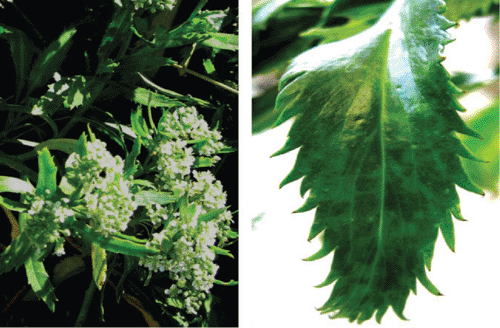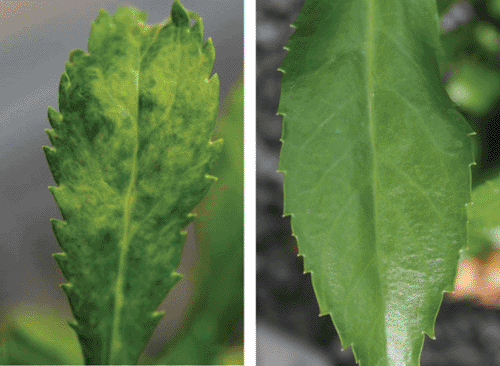First record of Turnip mosaic virus in Cook’s scurvy grass (Lepidium oleraceum agg.) − an endangered native plant in New Zealand
J. D. Fletcher A C , S. Bulman A , P. J. Fletcher A and G. J. Houliston BA New Zealand Institute for Plant and Food Research Limited, Private Bag 4704, Christchurch, New Zealand.
B Manaaki Whenua-Landcare Research, PO Box 40, Lincoln 7640, New Zealand.
C Corresponding author. Email: fletcherj@crop.cri.nz
Australasian Plant Disease Notes 4(1) 9-11 https://doi.org/10.1071/DN09004
Submitted: 9 January 2009 Accepted: 27 January 2009 Published: 2 March 2009
Abstract
Cook’s scurvy grass (Lepidium oleraceum agg.) is an endangered species of native Brassicaceae that is considered threatened with extinction. Virus-like disease symptoms were observed in a newly introduced plant of L. oleraceum at Stony Bay, Banks Peninsula, Canterbury, New Zealand. This is the first record of a virus in L. oleraceum and the first report of a Turnip mosaic virus infection in a New Zealand native host.
Of the indigenous Lepidium species in the Brassicaceae family, six are coastal, of which five are endemic to New Zealand (Lepidium banksii, Lepidium oleraceum agg., Lepidium obtusatum, Lepidium tenuicaule, Lepidium naufragorum), whereas Lepidium flexicaule also occurs in Tasmania (Hewson 1981). Cook’s scurvy grass (L. oleraceum) is an endangered species considered to be threatened with extinction (Norton and de Lange 1999).
There are few early (1840–42 and 1921) records of L. oleraceum from Banks Peninsula in Canterbury, New Zealand (Hugh Wilson, pers. comm. 2007). However, in December 2000, a population of L. oleraceum was discovered on Island Rock (2499350E, 5701240N: 43°53′43.84′S 172°52′2.90′E) off Island Bay on the south side of Banks Peninsula. Plants were collected from this site and then propagated at Landcare Research in the glasshouse for restoration plantings by the Department of Conservation Mahaanui Area Office (DOC), Christchurch. A plant from this population was re-introduced to Stony Bay (43°51′41.98′S 173°2′39.05′E) on the north side of the peninsula. During September 2007, this plant was examined and found to have mosaic mottling symptoms typical of a plant virus infection. Tissue was removed for further examination. In addition, 10 plants of L. oleraceum recently collected from Island Rock as part of the DOC re-establishment program were also examined for virus symptoms.
The Lepidium at Stony Bay (SB) exhibited inter-veinal yellow mottling, mosaic, distortion and twisting of the leaves (Fig. 1). Of the 10 further plants (LA−LJ) seven showed similar symptoms (Fig. 2). In general, symptoms were more pronounced in the glasshouse-grown plants collected for conservation.

|

|
Crushed leaf sap from leaf specimens from seven of the 10 plants tested positive for Turnip mosaic virus (TuMV) (Potyviridae) (mean of controls + 3 × sd) using double antibody sandwich enzyme-linked immunosorbent assay (DAS-ELISA) (AS0132, DSMZ, Germany). TuMV infection was further confirmed by reverse transcriptase polymerase chain reaction (RT–PCR). RNA was extracted from ~1 cm2 leaf discs of five TuMV-infected plants (SB, LD, LF, LG, and LJ) using the RNeasy Plant Mini Kit (Qiagen, Germantown, MD, USA). RNA was reverse transcribed using the SuperScript III First-Strand Synthesis System for RT–PCR (Invitrogen, Auckland, New Zealand), according to the manufacturer’s instructions. RT–PCRs were carried out using the TuMVF1 (5′-GCACAAGAAGAGGGAAAACG-3′) and TuMVR1 (5′-TGCACCAGACCATTAAACCA-3′) primers, designed from the sequence of a New Zealand TuMV isolate (GenBank accession AY995214). Cycling conditions were a denaturation step of 94°C for 2 min, followed by 35 cycles of 94°C (20 s), 55°C (20 s), 72°C (30 s). The expected ~290 bp DNA fragment was amplified from all five samples, while RT-negative and H2O-negative PCR reactions did not give DNA amplification. In subsequent work, PCR products from the five samples were sequenced and were confirmed to be from more than one TuMV isolate; phylogenetic analysis of these isolates will be presented elsewhere.
Material from the five selected symptomatic plants was used to mechanically inoculate appropriate herbaceous indicator plants, including Brassica pekinensis cvv. ‘Chi hi li’ and ‘Pak Choi’, B. oleracea var. capitata cv. ‘Flower of Spring’, B. oleracea var. botrytis cv. ‘White Acre’, C. amaranticolor, Chenopodium quinoa, Nicotiana glutinosa, Raphinus sativus cv. ‘Gentle Giant’, R. sativus cv. ‘French Breakfast’ and Sinapsis alba. Symptoms on all hosts appeared characteristic of those for TuMV infection as summarised in Provvidenti (1996). Some differences in host response between isolates were observed. In particular, B. pekinensis cv. ‘Pak Choi’ exhibited a clear mottled mosaic in LF and LG compared with a milder vein banding in LD, LJ and SB infected plants, indicating that two virus strains may be present.
TuMV is found in New Zealand in a wide range of hosts (Pearson et al. 2006). In Canterbury, large areas of Brassica rapa (turnip) and Brassica napus var. napobrassica (swede) have been grown regularly for sheep and cattle fodder. This is the first record of a virus in L. oleraceum and the first report of a TuMV infection in a New Zealand native host. TuMV is transmitted by aphid species that may be found on these hosts. Myzus persicae and Brevecoryne brassicae are the two most common vectors of TuMV (Karl 1971), of which the latter has been recorded on other Lepidium spp. (Norton and de Lange 1999). Cavariella aegopodii, Myzus cerasi and Myzus ornatus are also reported to colonise L. oleraceum (Teulon et al. 2004; www.crop.cri.nz/home/plant-synz/database/databasehome.php).
It is of concern that virus-infected clones of this rare and endangered plant may be accidentally introduced into protected areas. We have been working with DOC to screen and select suitable TuMV-free clones for re-introduction.
Acknowledgements
We thank Sonia and Mark Armstrong for allowing access to their property at Stony Bay. We also thank Hugh Wilson for his notes detailing L. oleraceum and its history on Banks Peninsula.
Hewson HJ
(1981) The genus Lepidium L. (Brassicaceae) in Australia. Brunonia 4, 217–308.
| Crossref |

Karl E
(1971) New vectors for some non-persistent viruses. Archiv fur Pflanzenschutz 7, 337–342.

Pearson MN,
Clover GRG,
Guy PL,
Fletcher JD, Beever REB
(2006) A review of the plant virus, viroid and mollicute records for New Zealand. Australasian Plant Pathology 35, 217–252.
| Crossref | GoogleScholarGoogle Scholar |



